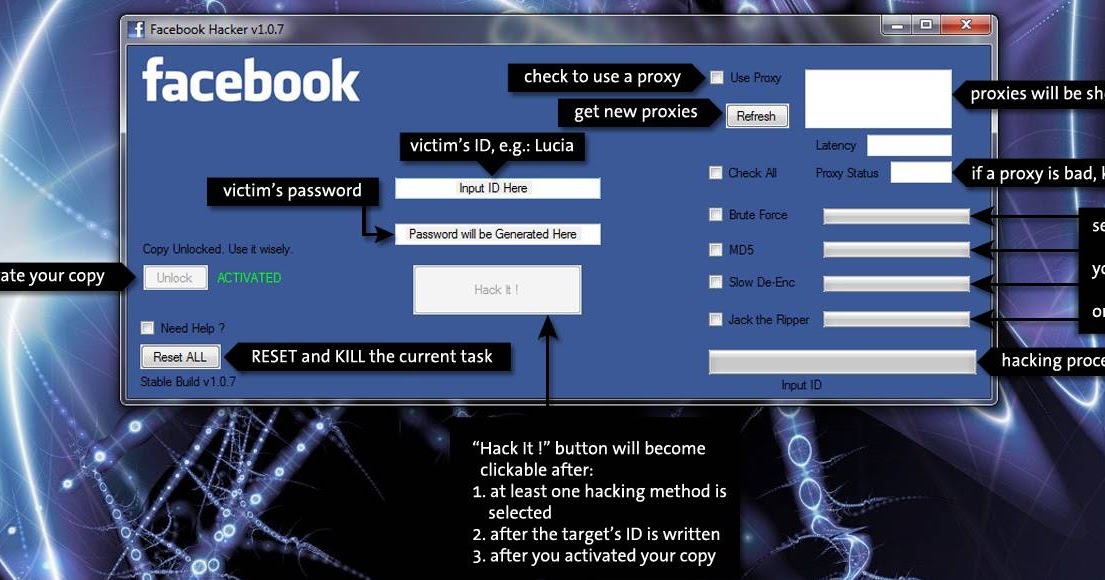

Part 7: #7 Best Facebook Hack Tool – Minspy Global.Part 6: #6 Best Facebook Hack Tool – FlexiSPY.Part 5: #5 Best FB Hacker App – iKeymonitor.Part 3: #3 Best Facebook Hacker App – mSpy.Part 2: #2 Best Facebook Hacker App – Spyic.Part 1: #1 Best Facebook Hacker App – Neatspy.Avoid any sites that limit you to short passwords or restricts the characters you can use. Avoid any sites that use SHA1 or MD5 as their password hashing algorithm. Rainbow tables offer a wide range of attacking potential.

Also, attackers are limited to the values contained in the table (otherwise, they must add another entire table). Pros: Can figure out complex passwords in a short amount of time grants the hacker a lot of power over certain security scenarios.Ĭons: Requires a huge amount of space to store the enormous (sometimes terabytes) rainbow table. Hackers can purchase prefilled rainbow tables populated with millions of potential combinations.
FACEBOOK PASSWORD HACKER V4.0 REVIEW CRACK
Using a rainbow table drastically decreases the time it takes to crack a hashed password-but it isn't perfect. Instead of having to process hundreds of thousands of potential passwords and matching their resulting hash, a rainbow table is a huge set of precomputed algorithm-specific hash values.

This where the rainbow table comes into its own. In other cases, the encryption algorithm is vulnerable, and most passwords are already cracked, like MD5 (hence why we know the specific hash for "logmein." But in certain cases, the attacker will run a list of plaintext passwords through a hashing algorithm, comparing the results against an encrypted password file. This means it looks completely different from the original password.įor instance, your password is (hopefully not!) logmein. For example, an attacker has acquired a list of user names and passwords, but they're encrypted.
FACEBOOK PASSWORD HACKER V4.0 REVIEW OFFLINE
Avoid posting personal information that could be later used against you.Ī rainbow table is usually an offline password attack. Education and security awareness is a core mitigation tactic. A successful social engineering attack will be complete by the time you realize anything is wrong. It's extremely stealthy.Ĭons: A social engineering failure can raise suspicions about an impending attack, and uncertainty as to whether the correct information is procured. It can be deployed against almost anyone, anywhere. Pros: Skilled social engineers can extract high-value information from a range of targets. When someone says they were tricked into revealing their password, it is often the result of social engineering. It could be a fake plumber or electrician asking for entry to a secure building, and so on.
This is because the attack won't always ask directly for a password. Being duplicitous to gain entry to a secure area is a common method of attack and one that is only guarded against with education. Social engineering has existed for centuries. The "attacker" tells the person on the phone they are the new office tech support team, and they need the latest password for something specific.Īn unsuspecting individual may hand over the keys without a pause for thought. For instance, a security company will phone the business they are auditing. Social engineering is essentially phishing in the real world, away from the screen.Ī core part of any security audit is gauging what the entire workforce understands. Remember, this is just for Kaspersky, so the real number is much higher. Furthermore, the volume of malicious attachments is high, too, with Kaspersky noting over 92 million malicious attachments from January to June 2020. The daily spam volume sent worldwide remains high, accounting for over half of all emails sent globally. User credentials are stolen, sold, or used nefariously (or both). The unsuspecting target user enters their login credentials and is either redirected or told to try again. This link actually connects to a fake login portal, mocked up to appear exactly the same as the legitimate site. Spoofed email demands immediate attention, featuring a link to a website. Target user receives a spoofed email purporting to be from a major organization or business. General phishing emails send by the billions to all manner of internet users around the globe.Ī phishing email generally works like this: This isn't strictly a "hack," but falling prey to a phishing or spear-phishing attempt will usually end badly.


 0 kommentar(er)
0 kommentar(er)
